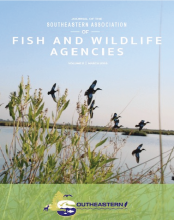Variation in Trotline Catfish Catch and Bycatch Rates by Hook and Bait Type in the New River, Virginia
The New River, Virginia, supports a trotline fishery for catfish (Ictaluridae) that coexists with popular recreational fisheries for smallmouth bass (Micropterus dolomieu), muskellunge (Esox masquinongy), and walleye (Sander vitreus), yet no studies have examined trotline catches or bycatch of these game fish. Trotline effort was estimated by conducting off-site interviews of trotline fishers and field counts of active trotlines. Catch of catfish and bycatch were estimated with experimental trotline sets that used circle or J hooks and two bait types (i.e., live or cut bait). Catch...
